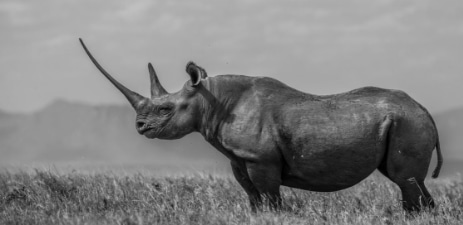THE GIRL ON THE HILL
LEWA, KENYA – 2017
This image of one of the biggest horned black rhinos in the world—called Waiwai—caused quite a stir and was a reminder that the use of social media is a double-edged sword. It is a forum that enfranchises everyone.
Almost everyone who works in conservation in East Africa knows
that Lewa Conservancy is a paragon in conservation. The efforts of Ian Craig and his team have allowed the rhino population to double over the last 10 years. The funding from NGOs such as Tusk has been crucial, as has the work ethic of the rangers and Ian and his family. Lewa is a great success story, and rhinos are emblematic of that success. Poachers now have very little chance in Lewa; they are heavily outfinanced, outnumbered, and outskilled. This is the model for the whole of Africa.
But when I posted this image on Instagram and said it had been taken in Lewa, some animal activists were not happy. Some even claimed I had signed the death warrant of the rhino by giving away her location. Comments attract other comments, and a storm can be whipped up in a very short amount of time. It served as an insight into how quickly and strongly reactions can be formed on social media.
For one, Lewa is 97 square miles, and rhinos don’t stay in one spot for long. Second, it is no secret that rhinos live in Lewa, just as it is no secret that the US president lives in the White House. And last, as the numbers empirically show, poachers have had no joy in Lewa for years. Photographs like this one help raise awareness and money, and rhinos in Lewa are indeed something to be celebrated, not something to keep covert for fear of the poacher.






